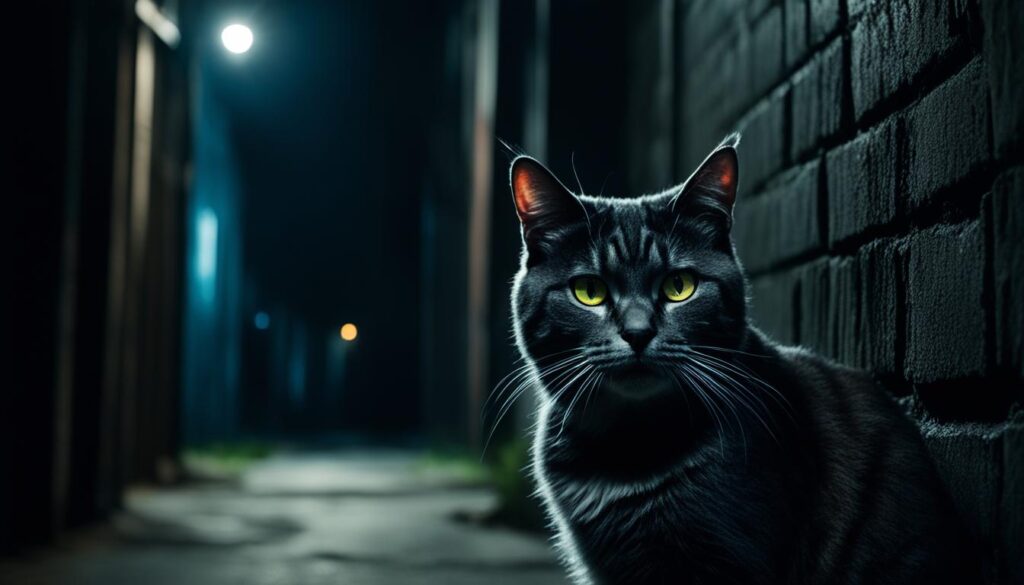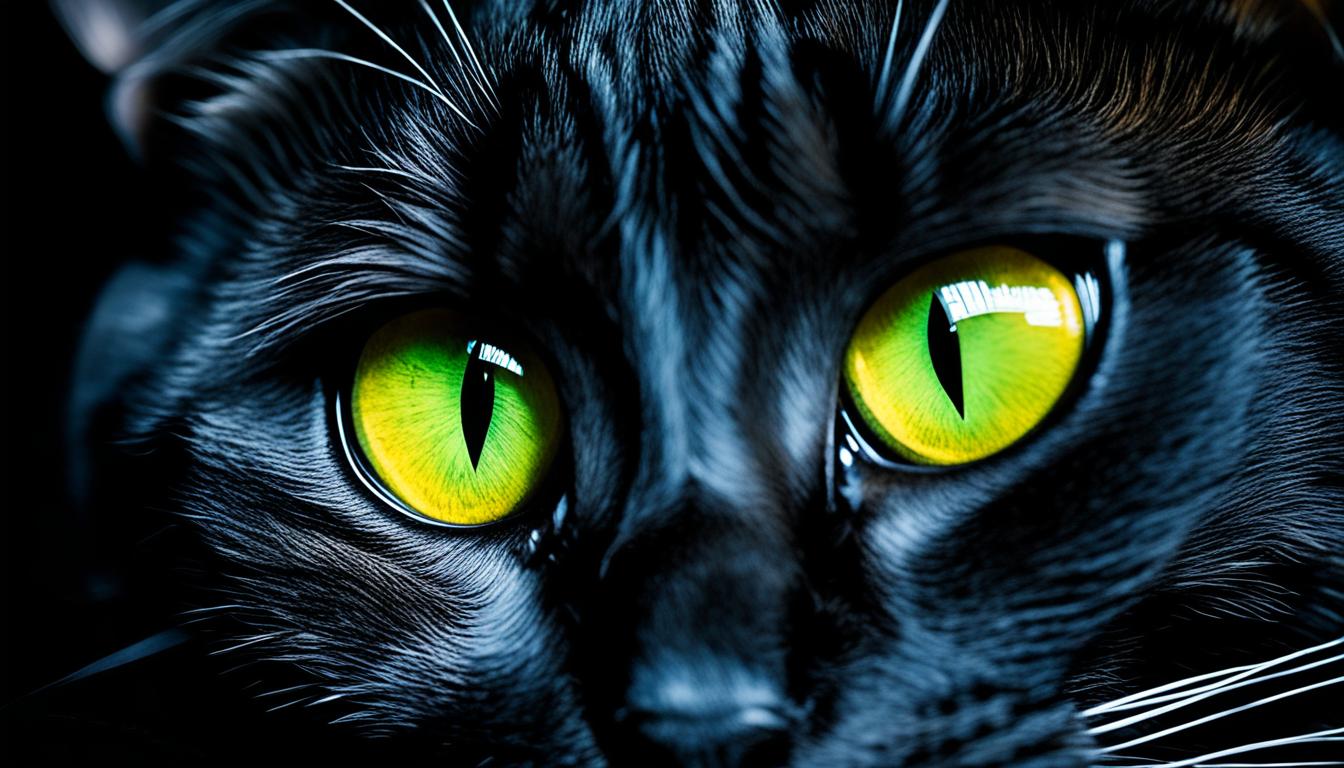If you are a fan of Stephen King’s horror stories, you will love “Cat’s Eye” – a collection of three interconnected tales that blend supernatural elements with spine-tingling suspense. Originally published in 1985, this novel has become a classic in the horror genre, leaving readers with a mix of terror and intrigue that only King can deliver.
Key Takeaways
- “Cat’s Eye” is a thrilling Stephen King novel that consists of three interconnected tales.
- The novel explores supernatural elements and suspense to create an immersive experience for readers.
- The main characters in the novel each have their own stories, but their lives become intertwined as the plot unfolds.
- Stephen King’s writing style in “Cat’s Eye” is characterized by vivid language and masterful suspense-building techniques.
- “Cat’s Eye” has garnered both positive and negative reviews, but its impact on the horror genre is undeniable.
The Plot of “Cat’s Eye”
“Cat’s Eye” is a collection of three interconnected stories that revolve around a central theme of the supernatural. In the first story, a small supernatural creature terrorizes a young girl and her family, drawing its life force from her fear. The second story follows a man who tries to quit smoking and visits a sinister clinic that uses extreme measures to help him kick the habit. Finally, in the third story, a gambler gets caught up in a dangerous game with a wealthy businessman that has deadly consequences.
Throughout the book, characters discover that the supernatural has a significant impact on their lives and their fates. The themes of addiction, fear, and the supernatural pervade the stories, creating a suspenseful and eerie atmosphere. Stephen King masterfully interweaves these tales, resulting in a unique and unsettling reading experience.
The interconnected stories in “Cat’s Eye” revolve around themes that are integral to Stephen King’s works, such as the supernatural and the impact it has on characters’ lives. Readers are taken on a journey through the terror and intrigue of these stories, making for a compelling read that leaves a lasting impression.
Main Characters in “Cat’s Eye”
Stephen King’s “Cat’s Eye” features a range of memorable and nuanced characters that contribute to the complex and interconnected storylines of the novel.
The Cat
While not a traditional protagonist, the titular cat plays a central role in the novel, appearing in each of the interconnected stories. The cat is depicted as a mysterious and cunning creature, possessing an otherworldly awareness and a connection to the supernatural forces that drive the narrative.
Johnny
Johnny is the protagonist of the first story in “Cat’s Eye,” “Quitters, Inc.” He is a smoker attempting to quit and turns to a mysterious organization for help. Johnny’s story is marked by themes of addiction and the lengths people will go to overcome it.
Cressner
Cressner is the antagonist of the second story, “The Ledge.” A wealthy and sadistic businessman, he subjects his wife’s lover to a dangerous game of chance, with potentially fatal consequences. Cressner embodies themes of power and control, and the corrupting effects of wealth and privilege.
Amanda
The final protagonist is Amanda, a young girl with supernatural powers who is pursued by a mysterious organization in “The General.” Amanda’s story is defined by themes of fear, isolation, and the struggle to understand and control her own abilities.
Themes in “Cat’s Eye”
Stephen King’s horror fiction often explores the depths of human fears and desires, and “Cat’s Eye” is no exception. The novel contains a variety of interconnected stories that revolve around a central theme of the supernatural and the ways in which it affects the lives of the characters.
Fear
One of the major themes in “Cat’s Eye” is fear. Throughout the book, characters are haunted by their own fears, whether they are rational or not. The supernatural elements in the stories elevate these fears to new heights, making them all-consuming and overwhelming. From the fear of heights to the fear of death, fear plays an integral role in the narrative of “Cat’s Eye.”
Addiction
Another theme present in “Cat’s Eye” is addiction. Characters in the book struggle with various forms of addiction, such as smoking or gambling, and these addictions often lead them down a dangerous path. The addiction functions as a metaphor for the characters’ inability to resist temptation and their desire for control.
The Power of the Supernatural
Finally, the supernatural itself is a central theme in “Cat’s Eye.” The stories are filled with mysterious forces that are beyond the understanding of the characters. The power of the supernatural is both awe-inspiring and terrifying, creating an eerie atmosphere that pervades the entire book.
Stephen King masterfully weaves these themes together to create an atmospheric and chilling reading experience that lingers long after the book is finished.
Stephen King’s Writing Style in “Cat’s Eye”
Stephen King is known for his distinctive writing style that captivates readers with its vivid descriptions and ability to create suspenseful atmospheres. “Cat’s Eye” is no exception, as King expertly weaves together interconnected stories that keep readers on the edge of their seats.
One of the hallmarks of King’s writing style is his use of descriptive language to create a vivid, sensory experience for readers. In “Cat’s Eye,” King portrays the eerie settings and supernatural occurrences in intricate detail, allowing readers to immerse themselves in the story’s world.

King also excels at building suspense and tension throughout his stories, with “Cat’s Eye” being a prime example. From the very first page, readers are drawn into the story and left wondering what the next twist will be.
Finally, King’s ability to craft memorable scenes is perhaps most evident in “Cat’s Eye.” Whether it’s the eerie carnival atmosphere or the heart-pounding moments when the supernatural takes over, King’s prose leaves a lasting impression on readers long after they finish the book.
Critical Reception of “Cat’s Eye”
Upon its release, “Cat’s Eye” received mixed reviews, with some critics praising Stephen King’s skillful blend of horror with elements of suspense and dark humor, while others criticized the lack of depth in some of the interconnected stories.
Despite the mixed critical reception, “Cat’s Eye” remained a commercial success, earning a spot on the New York Times Bestseller list for several weeks.
Over time, the novel has solidified its place as a classic in the horror genre, further cementing Stephen King’s reputation as a master of horror fiction.
Positive Reviews
- “Stephen King writes with a unique blend of skill, terror, and dark humor that creates a completely immersive reading experience. “Cat’s Eye” might be one of his lesser-known works, but it’s just as chilling and suspenseful as any of his bestsellers.” – Publishers Weekly
- “King’s fiction is always characterized by a sense of the real nature of horror and has an ability to inspire genuine terror in his readers. “Cat’s Eye” is no exception, delivering all the classic elements of horror fiction while still maintaining a sense of humanity and depth.” – Leonard J. Buchanan, Horror Review
Negative Reviews
- “While “Cat’s Eye” has its moments of brilliant storytelling and suspense, some of the interconnected stories fall flat. King fails to fully develop certain characters and plot points, leaving the reader unsatisfied at times.” – The Boston Globe
- “King’s writing is sometimes too pulpy for its own good, and “Cat’s Eye” suffers from an overreliance on cheap thrills and obvious foreshadowing.” – Genevieve Cogman, The Guardian
Connections to Other Stephen King Works
As with many Stephen King novels, “Cat’s Eye” exists within the larger Stephen King universe, featuring connections and references to other works in his extensive body of horror fiction. For example, the character of Cujo, the rabid Saint Bernard from the novel of the same name, makes a cameo appearance in one of the storylines. Additionally, the character of Richard Hazlett, from the novel “The Dark Half,” is referenced in another storyline.
Furthermore, “Cat’s Eye” contains Easter eggs for dedicated King fans, such as the appearance of a logo for the fictional town of Castle Rock, which serves as the setting for many of King’s stories. These connections add to the richness and depth of the Stephen King universe, making reading his works a rewarding experience for fans of his horror fiction.

Film Adaptation of “Cat’s Eye”
The film adaptation of “Cat’s Eye” was released in 1985 and directed by Lewis Teague. The movie consists of three interconnected stories, like the novel, with a stray cat serving as the thread that connects them. The first story follows a smoker named Richard Morrison as he attempts to quit smoking by undergoing a bizarre treatment that involves being chased by electric shocks. The second story follows a man named Johnny Norris as he attempts to win a bet by walking around the ledge of a skyscraper. The final story follows a family that becomes terrorized by a tiny troll who sneaks into their home and steals their young daughter’s breath in the middle of the night.
The film successfully captures the essence of Stephen King’s storytelling, creating a suspenseful and terrifying experience for viewers. The visual elements of the movie, such as the use of lighting and sound effects, further enhance the horror elements of the story.
Despite its critical reception being mixed, the “Cat’s Eye” movie remains a popular entry in the canon of Stephen King adaptations. Its impact on the genre of horror film has been significant, and its influence can be seen in subsequent works, as well as in the visual representations of King’s other stories.
The importance of the visual in “Cat’s Eye” adaptation
One important aspect of the “Cat’s Eye” movie that differs from the novel is its visual representation of the supernatural elements in the story. The film adaptation incorporates special effects and visual imagery to create a more tangible representation of the book’s supernatural forces. The tiny troll, in particular, is given a much more vivid visual identity in the movie than in the novel, making it a more frightening antagonist.
The use of lighting and camera angles also plays a crucial role in enhancing the horror elements of the film, creating tension and suspense that keeps the viewer engaged throughout. Overall, while the “Cat’s Eye” movie may not be a faithful adaptation of Stephen King’s novel, it is a successful one, both in capturing the essence of the story and creating a unique visual representation of its supernatural elements.
Legacy of “Cat’s Eye” and its Impact on Horror Fiction
“Cat’s Eye” remains one of the most iconic works of Stephen King, and its legacy in the world of horror fiction is undeniable. Its unique blend of horror, suspense, and supernatural elements has influenced countless authors and filmmakers, establishing King’s position as a master of the genre.
The impact of “Cat’s Eye” extends beyond the realm of horror fiction as well. Its exploration of addiction, fear, and the human psyche has resonated with readers and critics alike, cementing its status as a timeless work of fiction.
Stephen King’s influence on the horror genre cannot be overstated, and “Cat’s Eye” is a prime example of the power of his storytelling. Its lasting impact on popular culture, from its references in other works to its enduring reputation as a classic horror tale, is a testament to King’s talent and the enduring appeal of the genre.
In the decades since its initial publication, “Cat’s Eye” has continued to captivate and terrify readers worldwide, solidifying its place in the pantheon of horror fiction. Its legacy endures, and its impact on the genre and popular culture at large is a testament to the enduring power of Stephen King’s storytelling.
FAQ
What is “Cat’s Eye”?
“Cat’s Eye” is a thriller novel written by renowned author Stephen King. It combines elements of horror and intrigue to keep readers on the edge of their seats.
What is the plot of “Cat’s Eye”?
“Cat’s Eye” follows a series of interconnected stories that revolve around the supernatural. The book explores the impact of the paranormal on the lives of its characters, creating a captivating and suspenseful narrative.
Who are the main characters in “Cat’s Eye”?
The novel features a diverse cast of characters, each with their own unique backgrounds and motivations. From troubled individuals to those who encounter supernatural phenomena, these characters play pivotal roles in driving the storyline forward.
What are the themes explored in “Cat’s Eye”?
“Cat’s Eye” delves into various themes such as fear, addiction, and the power of the supernatural. Stephen King expertly weaves these themes into the narrative, creating a compelling and chilling reading experience.
What is Stephen King’s writing style like in “Cat’s Eye”?
In “Cat’s Eye,” Stephen King showcases his mastery of descriptive language and ability to build suspense. The book is filled with memorable scenes and gripping prose, which are characteristic of King’s unique writing style.
How was “Cat’s Eye” received by critics?
“Cat’s Eye” received a mix of positive and negative reviews from critics. While some praised King’s ability to create a sense of unease and atmosphere, others felt that the novel fell short in comparison to his other works. Nonetheless, the book played a significant role in solidifying King’s reputation as a master of horror.
Are there any connections to other Stephen King works in “Cat’s Eye”?
Yes, “Cat’s Eye” contains connections and references to other Stephen King works. This is part of King’s larger shared universe, and fans of his other novels will enjoy discovering these Easter eggs.
Has “Cat’s Eye” been adapted into a film?
Yes, “Cat’s Eye” has been adapted into a film. The movie captures the essence of Stephen King’s storytelling and enhances the visual elements, providing a different yet equally engrossing experience for fans of the novel.
What is the legacy of “Cat’s Eye” in the world of horror fiction?
“Cat’s Eye” holds a significant place in the world of horror fiction, showcasing Stephen King’s mastery of the genre. Its impact extends beyond its initial release, inspiring subsequent works and contributing to King’s overall influence as a prominent figure in the literary world.



